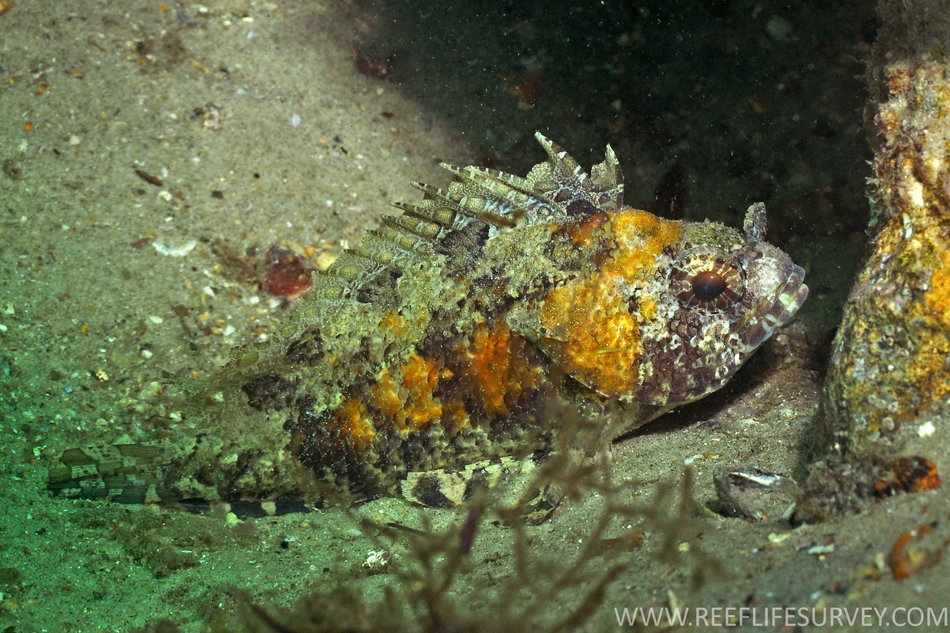Centrogenys pogonoskii Matsunuma & Johnson 2024
Other Names: False Scorpion-fish, Pretty-fins

A False Scorpionfish, Centrogenys vaigiensis, at North Stradbroke Island, Moreton Bay, Queensland. Source: Rick Stuart-Smith / Reef life Survey. License: CC by Attribution
Summary:
In Australia, this species was previously known as Centrogenys vaigiensis.
Cite this page as:
Bray, D.J. 2024, Centrogenys pogonoskii in Fishes of Australia, accessed 01 Jul 2025, https://fishesofaustralia.net.au/home/species/4526
Centrogenys pogonoskii Matsunuma & Johnson 2024
More Info
|
Distribution |
Widespread in northern Australia, from Shark Bay, Western Australia, to the Gold Coast, south of Moreton Bay, Queensland. Elsewhere the species occurs in the Torres Strait, Papua New Guinea. Inhabits inshore sand and rubble areas, commonly in seagrass and macroalgal beds, often with corals. |
|
Feeding |
An ambush predator that feeds on small fishes, shrimps, and crabs. |
|
Etymology |
The species is named for Mr. John Pogonoski (CSIRO), for his great contributions to the marine fish taxonomy in Australia and generous assistance in finding this new species. |
|
Species Citation |
Centrogenys pogonoskii Matsunuma & Johnson 2023, Ichthyology & Herpetology 111(4): 515, Figs. 1D, 3C, 4F, 5F-G, 6I-K, 8D-F. Type locality: Shoalwater Bay, eastern tip of Sabina Point, Queensland, Australia, 22°23'45"S, 150°18'13.8"E. |
|
Author |
Bray, D.J. 2024 |
|
Resources |
Centrogenys pogonoskii Matsunuma & Johnson 2024
References
Allen, G.R. & Swainston, R. 1988. The Marine Fishes of North-Western Australia. A field guide for anglers and divers. Perth, WA : Western Australian Museum vi 201 pp., 70 pls. (as Centrogenys vaigiensis)
Fisher, C. & Calaby, J. 2009. The top of the top end: John Gilbert’s manuscript notes for John Gould on vertebrates from Port Essington and Cobourg Peninsula (Northern Territory, Australia); with comments on specimens collected during the settlement period 1838 to 1849, and subsequently. The Beagle, Records of the Museums and Art Galleries of the Northern Territory Supplement 4:1– 240.
Gloerfelt-Tarp, T. & Kailola, P.J. 1984. Trawled Fishes of Southern Indonesia and Northwest Australia. Jakarta : Dir. Gen. Fish. (Indonesia), German Tech. Coop., Aust. Dev. Ass. Bur. 406 pp. (as Centrogenys vaigiensis)
Leis, J.M. & Trnski, T. 1999. Larval development of the Indo-Pacific perciform fish, Centrogenys vaigiensis (Pisces: Centrogeniidae). Ichthyological Research 46(4): 413-422. https://doi.org/10.1007/BF02673983
Matsunuma, M. & Johnson, J.W. 2023. Revision of the Indo-Pacific genus Centrogenys Richardson, 1842 (Centrogenyidae) with descriptions of two new species from Australia. Ichthyology & Herpetology 111(4): 503-521. https://doi.org/10.1643/i2022103
Sainsbury, K.J., Kailola, P.J. & Leyland, G.G. 1985. Continental Shelf Fishes of Northern and North-Western Australia. Canberra : Fisheries Information Service 375 pp. figs & pls.
Travers, M.J. & Potter, I.C. 2002. Factors influencing the characteristics of fish assemblages in a large subtropical marine embayment. Journal of Fish Biology 61(3): 764-784. (as Centrogenys vaigiensis)








